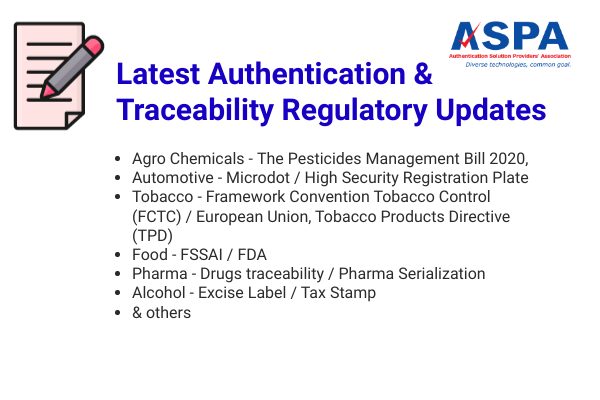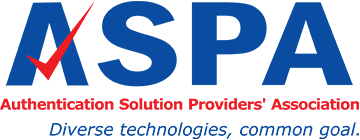
Be updated with the latest Global Anti-Counterfeiting, Authentication & Traceability Compliances, Regulations & Notifications Information
INDIA
MEDICINES AND MEDICAL DEVICES
January 2022: The Central government has mandated Quick Response (QR) code on the label of all active pharmaceutical ingredients (APIs) manufactured or imported in India, at each level packaging to enable tracking and tracing of the ingredients. The amendment Rule is scheduled to come into force from January 1, 2023.Click here to view notification
January 2022: The ministry of health and family welfare has decided to extend the date of implementation of the unique device identification (UDI) of medical devices, which was to come into effect from January 1, 2022, till further orders. Click here to view notification
October 2020: This policy paper outlines the features of existing traceability systems and provides guidance on developing workable traceability regulation. In the light of the widely varying needs, capacity, and resources of Member States, the risk mitigation and sustainability strategies embedded in implementation efforts will vary. Given the range of possible implementation pathways, a set of guiding principles will assist Member States in establishing systems best suited to their needs and constraints. Click here to download paper
September 2020: The Department of Pharmaceuticals (DoP) has initiated the process of forming an empowered committee of drug regulatory officials and representatives of pharmaceutical industry to examine varied track & trace technologies and come out with an authentication mechanism to address spurious drug issues. Click here to view news
July 2020: Health Ministry to introduce QR Code for drugs sold in domestic market to control spurious and sub-standard drugs, Click here to view news
2020: Pharmexcil release user manual for Integrated validation of exports of drugs from India and its authentication (iVEDA): Pharmaceutical Export Council of India (Pharmexcil) in association Centre for Development of Advanced Computing (CDAC) release user manual for Integrated validation of exports of drugs from India and its authentication. Click here to view the document
2020: DGFT extended date for Track and Trace: Directorate General of Foreign Trade in its notification dated 30th March 2020 has extended the date of implementation of track and trace sytem for export of pharmaceutical and drug forumulations in order to maintain the parent-child relationship in packaging levels and its uploading on central portal by both Small Scale Industries (SSI) and Non-SSI till 1st October 2020. Click here to view notification
2020: Drug marketers to be held responsible for quality: Pharmaceutical companies that market medicines made by third parties in the country will now be held responsible for drug product quality with the health and family welfare ministry on Thursday issuing a notification to this effect. Click here to view notification
2019: Pharma API packaging: CDSCO mandate every active pharmaceutical ingredient (API) packaging should bear Quick Response (QR) code on its label to facilitate tracking and tracing. Click here to view notification.
2019: DGFT Update: iVEDA portal to replace DAVA portal: As per the new directive, Pharmaceutical exporters in India will now have to implement the Track and Trace system. The Central system will be changed from DAVA to iVEDA (Integrated validation of exports of drugs from India and its authentication) portal from 01.10.2020. To register in the central portal (IVEDA), Manufacturers and Merchant exporters need to visit the IVEDA website click here to visit iVEDA and register.
2011: Drugs Authentication and Verification Application (DAVA): In India, the Directorate General of Foreign Trade passed a regulation in 2011 requiring all drug exporters to implement serialization and track-and-trace on primary, secondary and tertiary levels of packaging. This regulation has already been implemented on the tertiary level in 2011, the secondary level in 2013, and is slated to be in effect on the primary level in 2015. Track and trace and government reporting requirements are expected to follow in the coming years. The Indian Government have made a portal for Indian Drugs Authentication, Track and Trace called Drugs Authentication and Verification Application (DAVA).
LIQUOR / ALCOHOL BEVERAGES
February 2020, India: Goa announce tax stamps measures for alcohol revenue protection Click to view the document
February 2020: Rajasthan unveil excise policy 2020-21, plan to reintroduce security hologram with traceability Click to view the document
AUTOMOTIVE COMPONENTS
Notification allowing Motor Vehicles & their parts to be affixed with Microdots: The Ministry of Road Transport & Highways has issued a draft notification GSR 521(E) dated 24thJuly 2019, amending Central Motor Vehicle Rules, allowing motor vehicles and their parts, components, assemblies, sub-assemblies to be affixed with permanent and nearly invisible microdots that can be read physically with a microscope and identified with ultra violet light source.
High Security Registration Plate (HSRP) Scheme: The new High Security Registration Plate scheme is introduced throughout the country in respect of new vehicles from 31.05.2005 or any earlier date as may be notified by any State for their own State. Click here to view document
CHEMICALS AND FERTILIZERS
India: Government is likely to introduce seed traceability by June 2020: Department of Agricultural, Cooperation & Farmers Welfare wishes to put in place a Digital Traceability System, for traceability based on Global Traceability System (GTS) framework for the movement of seed across existing supply chain. Click here to download notification
EDUCATION
India: UGC Notification for Varisities to introduce identification mechanism : The University Grants Commission (UGC) has directed varsities and higher educational institutions to introduce identification mechanism like photograph of the student, hologram of the institute and QR codes in student certificates. Click here to download notification
E COMMERCE
July 2020, India: Government to soon roll out e-commerce policy to deal with counterfeit products
February, 2019, India: Government of India announce draft of E-Commerce Policy: The Department for Promotion of Industry and Internal Trade (DPIIT), Government of India unveil e-commerce policy for stakeholders feedback. Click here to view the document
FMCG- EDIBLE OILS
India: Ban on sale of loose edible oil can check adulteration: Indian Government has advised all State Governments to enforce a law preventing retailers from selling edible oil in loose form. Click here to read news
India: The Bureau of Indian Standards (BIS) has announced IS 15495 to ban use toluene in food packaging inks. Click here to download Standard Copy
USA, Nov 2013: Drug Supply Chain Security Act (DSCSA): The Drug Quality and Security Act (DQSA), was enacted by Congress on November 27, 2013. Title II of DQSA, the Drug Supply Chain Security Act (DSCSA), outlines steps to build an electronic, interoperable system to identify and trace certain prescription drugs as they are distributed in the United States. This will enhance FDA's ability to help protect consumers from exposure to drugs that may be counterfeit, stolen, contaminated, or otherwise harmful. The system will also improve the detection and removal of potentially dangerous drugs from the drug supply chain to protect U.S. consumers. Read the Drug Supply Chain Security Act. Find a list of DCSCA policy documents and the FDA's implementation plan. Additionally, read the key provisions of the law and find out if you are ready for DSCSA's requirements.
Feb 2020: Safety features for medicinal products for human use: This documents sets out frequently-asked 'questions and answers' regarding the implementation of the rules on the safety features for medicinal products for human use. Click here for more information
Nov 2019: Falsified Medicines: Aide-Memoire for Good Distribution Practices (GDP) inspections
Feb 2019: Falsified medicines: new rules to enhance patients' safety: From February 2019, the industry will have to affix a 2-D barcode and an anti-tampering device on the box of prescription medicines. The pharmacies – including on-line pharmacies – and hospitals will have to check the authenticity of medicines before dispensing to patients. This is the final step in the implementation of the Falsified Medicines Directive, adopted in 2011, aiming at guaranteeing the safety and quality of medicines sold in the EU. Click here for more information
2016: Commission Delegated Regulation (EU) 2016/161: Details the characteristics of the safety features, how medicine authenticity should be verified and by whom.
2011: Falsified Medicines Directive (FMD): Following adoption by the European Council and the European Parliament, the Falsified Medicines Directive (Directive 2011/62/EU) was published on 1 July 2011 and applies since 2 January 2013. It amended Directive 2001/83/EC. This Directive introduces harmonised European measures to fight medicine falsifications and ensure that medicines are safe and that the trade in medicines is rigorously controlled. Measures include:
- Obligatory safety features – a unique identifier and an anti-tampering device – on the outer packaging of medicines
- A common, EU-wide logo to identify legal online pharmacies
- Tougher rules on import of active pharmaceutical ingredients
- Strengthened record-keeping requirements for wholesale distributors.
WORLD HEALTH ORGANISATION (WHO) POLICY ON FALSIFIED AND SUB STANDARD MEDICINES:
WHO publishes its draft Policy brief on traceability of health products for comments: In the context of the 2030 target for UHC for all, the World Health Organization recognizes that traceability systems and technologies could be leveraged to ensure the integrity and efficiency of supply chains. However, outstanding questions remain for WHO Member States on the implementation of existing standards and approaches, as well as on an appropriate governance in terms of data (use and ownership).
ELECTRONICS
UK DCMS Published the Product Security and Telecommunications Infrastructure (PSTI) Bill - On Nov.24, 2021, the United Kingdom Department for Digital, Culture, Media and Sport (DCMS) published the Product Security and Telecommunications Infrastructure (PSTI) Bill, which aims to protect users against potential harm from unsafe consumer connected products. For more info, click here
TOBACCO
EUROPEAN UNION
January 2020: Summary record - Subgroup on Traceability and Security Features established by the Expert Group on Tobacco Policy. Click to view the document
May 2019: The systems became operational on 20 May 2019. Articles 15 and 16 of the Tobacco Products Directive 2014/40/EU (TPD) provide for EU-wide systems of traceability and security features for tobacco products to address the issue of illicit trade. To read press release, click here, To download FAQ on Tobacco traceability and security features: Questions and Answers. Click to view the document
WORLD HEALTH ORGANISATION (WHO), FRAMEWORK CONVENTION TOBACCO CONTROL
WHO, FCTC protocol to eliminate illicit trade in tobacco products: The Protocol to Eliminate Illicit Trade in Tobacco Products is the first protocol to the WHO Framework Convention on Tobacco Control (WHO FCTC), and a new international treaty. It was adopted by consensus on 12 November 2012 at the fifth session of the Conference of the Parties (COP) to the WHO FCTC (Seoul, Republic of Korea, 12–17 November 2012). The Protocol builds upon and complements Article 15 of the WHO FCTC, which addresses means of countering illicit trade in tobacco products, a key aspect of a comprehensive tobacco control policy.
UK (HMRC): The Tobacco Products (Traceability and Security Features) Regulations 2019
